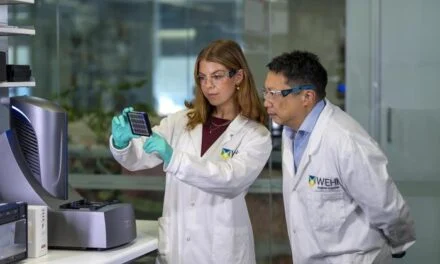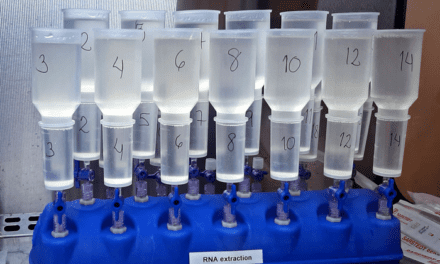Cairn Diagnostics, a provider of FDA-approved breath tests intended for routine use in diagnostic medicine, announced the inclusion of its 13C-Spirulina Gastric Emptying Breath Test (GEBT), in recently updated American, European, and International Consensus Clinical Guidelines* for evaluation of gastric emptying and diagnosis of gastroparesis (paralysis of the stomach) in patients ages 18 years and older.
Gastroparesis is a debilitating disease in which the stomach empties at an abnormally slow pace and is defined by delayed gastric emptying in the absence of mechanical obstruction. It is characterized by recurrent symptoms such as nausea, vomiting, early satiety, postprandial fullness, abdominal discomfort, and pain. Gastroparesis has clinical origins arising from diabetes, hypothyroidism, nervous system disorders, autoimmune disorders, viral infections, surgery, and idiopathic (unknown) reasons.
Awareness of gastroparesis in the clinical and obesity management community is increasing, with a growing number of gastroparesis cases now resulting from drug interventions such as narcotic pain medications and popular drugs used to treat diabetes and obesity. Semaglutide, in particular, is a drug that slows gastric emptying, making patients feel full and decreasing their appetite, which helps facilitate weight loss and improves glycemic control. Semaglutide is the active ingredient in familiar drugs such as Ozempic, Wegovy and Rybelsus. If these drugs are prescribed to patients that are unknowingly predisposed to gastroparesis, or if the dosage is not carefully titrated to recommended dosage protocols, this can induce moderate to severe gastroparesis.
Historically, clinical guidelines for diagnosis of gastroparesis have recommended using a radioactive four hour gastric emptying study conducted in a nuclear medicine center: a procedure known as Gastric Emptying Scintigraphy (GES). Today, clinicians and patients may alternatively choose Cairn’s innovative GEBT, a safe, non-radioactive, non-invasive, orally administered, FDA-approved, and standardized test to measure rates of gastric emptying and to help diagnose gastroparesis.
GEBT does not require nuclear medicine imaging equipment, specially licensed facilities or personnel, or radioactive material. The test can be administered in clinical practice or by virtually supervised telehealth conveniently in a patient’s home. Upon receipt of a patient’s breath samples at Cairn’s CLIA Laboratory, results can be reported within 24-48 hours. GEBT is now covered by Medicare (CMS) and is commercially available in the U.S.
Further reading: Breath Test Could Measure Antibiotic Levels
“Gastroparesis affects over 5 million people in the U.S. I We have an obesity crisis (approximately 40 percent of Americans being overweight), along with high prevalence of gastroparesis in diabetics, serious gastroparesis-related adverse events associated with popular weight loss drugs, and reluctance to give deep sedation to patients scheduled for endoscopy or surgery who are taking semaglutide,” says Kerry Bush, president & COO, Cairn Diagnostics. “Given the significantly elevated gastroparesis conversation among physicians, these recently updated U.S., EU and international standard of care guidelines underscore the need for the GEBT– a more widely available method for helping to rapidly diagnose this disease and improve health outcomes.”
GEBT provides a more convenient, timely modality for assessing gastric emptying, particularly in susceptible populations such as diabetics, idiopathic gastroparetic patients, neurologically affected patients, and tender populations where radiation is best avoided. Examples include: patients and clinicians preferring to avoid radiation (gastroparesis is 4-times more prevalent in women than men); patients needing more than one evaluation; those living in smaller and rural communities where nuclear medicine assets are unavailable; and those encountering long scheduling times (up to 3 months) for the nuclear medicine procedure in major metropolitan areas (including academic medical centers), causing delays in evaluation and diagnosis. Contrary to nuclear medicine-based GES, GEBT is always conducted in exactly the same manner over a 4-hour period per Clinical Guideline recommendations.
GEBT was validated in FDA-approved, dual-labeled clinical validation studies (Mayo Clinic, Rochester) against the 4-hour radioactive Gastric Emptying Scintigraphy (GES) procedure, which is considered the conventional method of assessing gastric emptying and must be conducted in specially licensed nuclear medicine facilities.ii
References
i. Centers for Disease Control and Prevention. Long-term Trends in Diabetes. CDC’s Div Diabetes Transl. Published online 2014.
ii. Szarka L, et al. A stable isotope breath test with a standard meal for abnormal gastric emptying of solids in the clinic and in research. Clinical Gastroenterology and Hepatology. June 2008; 6(6):635-643. Available at http://www.ncbi.nlm.nih.gov/pubmed/18406670.
iii. Jurisdictions JJ, JM and MolDx, Palmetto GBA, July 2020; Billing & Reimbursement – 13C-Spirulina GEBT. Accessed June 24, 2021. https://cairndiagnostics.com/billing/
* ACG Clinical Guideline: Gastroparesis: https://journals.lww.com/ajg/Fulltext/2022/08000/ACG_Clinical_Guideline__Gastroparesis.15.aspx?context=FeaturedArticles&collectionId=2
Photo: Cairn Diagnostics





